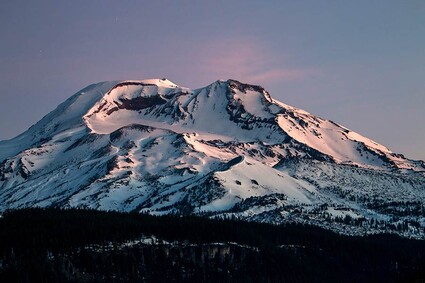Bulge is reminder that we live among volcanoes
Last updated 2/9/2022 at Noon

Jarod Gatley
A bit of uplift in the Three Sisters Volcano complex is no cause for alarm —but an interesting reminder of the geology of the region we call home.
Scientists have detected an increase in the rate of uplift of the ground surface in the Three Sisters volcanic region of the Central Oregon Cascade Range. The United States Geologic Survey (USGS) released an information statement last week from the Cascades Volcano Observatory with respect to Three Sisters Volcano (complex).
The volcanoes’ status remains normal/green, and there is no sign of an imminent eruption. Episodes of increased uplift have been observed in this area before and are attributed to small pulses of magma moving deep into the volcanic region.
Jon Major, scientist in charge at the observatory, said the activity is probably coming from pulses of magma moving about four miles underground.
“There’s no imminent threat,” he said. “Our interpretation is it’s probably related to ongoing small inputs of magma deep underground. If the volcano were close to erupting, the magma would be breaking more rock, generating bigger earthquakes, releasing gases, and lifting the ground at a much faster pace,” Major said.
“There would be a lot more signs that magma was making its way to the surface and poised for an eruption,” he elaborated, adding, “We’re not seeing any of that right now.”
The last eruption on any of the Three Sisters was a mere 2,200 years ago – yesterday in geologic time. The stratovolcanoes were constructed between 150,000 and 50,000 years ago for North Sister and 50,000 to 15,000 years ago for Middle and South.
What USGS is seeing with the aid of satellite imagery is an upward shift in the ground of less than an inch, across a 12-mile area west of South Sister. One might ask if it’s even worth mentioning. Maybe. Maybe not. But if USGS finds it interesting, then by extension so do we, yet in a wider context.
There are moraine-damned lakes on the Sisters, some of which hold a lot of water. These freshwater lakes are formed behind a moraine or ice dam. One in particular, Carver Lake on the east side of South Sister about 12 miles from town, could be breached in the event of a major seismic event. Should we worry?
Not seriously, according to scientist David George, who studies in detail things most would find tedious. George notes that the outlet channel for Carver is a small tributary of Whychus Creek. Models, however, illustrate that a big chunk of town could be under anywhere from .05 to .25 meters (1.95 to 9.75 inches) of water, and in areas close by Whychus and smaller creeks, double that.
That would seem fairly catastrophic to the untrained observer. But George explained in a seven-page technical report: “Compared to earlier studies employing 1-D equations and coarse topography, our modeling suggests a strikingly different result for our test case involving inundation near Sisters. Owing in part to the use of 2-D equations as well as high-resolution lidar topography, our results suggest that flow avulsion and diversion on the alluvial fan surrounding Sisters would lead to a less severe flood hazard to the community.” (Emphasis added.)
Seismic activity like this also gets the attention of the Forest Service, who maintains two earthen dams at Upper and Lower Three Creeks Lake. Sisters District Manager Ian Reid tells The Nugget that it is only coincidental that these dams are under review in 2022.
“It’s part of a routine inspection and analysis that we undertake every so many years,” he said. “These are old dams.”
The larger of the lakes is 28 acres and is 28 feet deep in the center. That equates to about 230 million gallons of water. Reid says that water, if breached, would not find its way to the city. And while old and under observation, there is nothing to suggest an imminent break.
Officials regularly warn of a potentially devastating earthquake at the Cascadia Subduction Zone just off the Oregon coast. Central Oregon is affected by the same subduction zone, which created the Cascades millions of years ago. At the Cascadia Subduction Zone, the Juan de Fuca Plate is being subducted under the North American Plate, creating the potential for both quakes and eruptions.
When that happens, the plate goes down and creates lava, magma. Below the Cascades, there are magma chambers. It’s simple: the Cascade Mountain Range is an active volcanic area, and activity occasionally reminds us that we live among volcanoes.












Reader Comments(0)